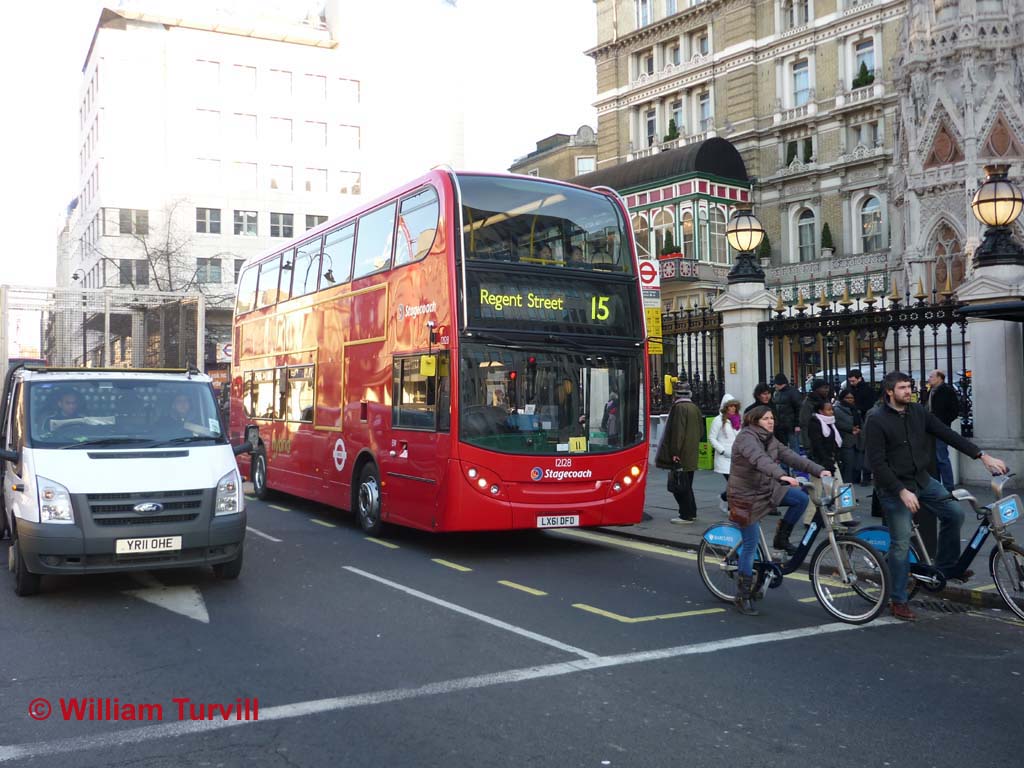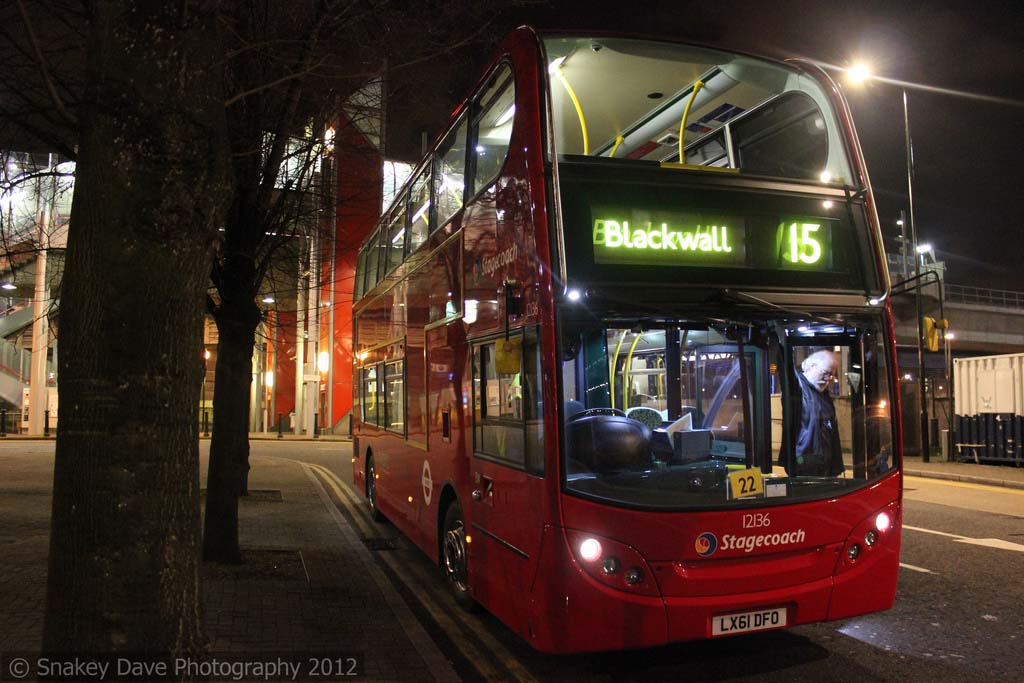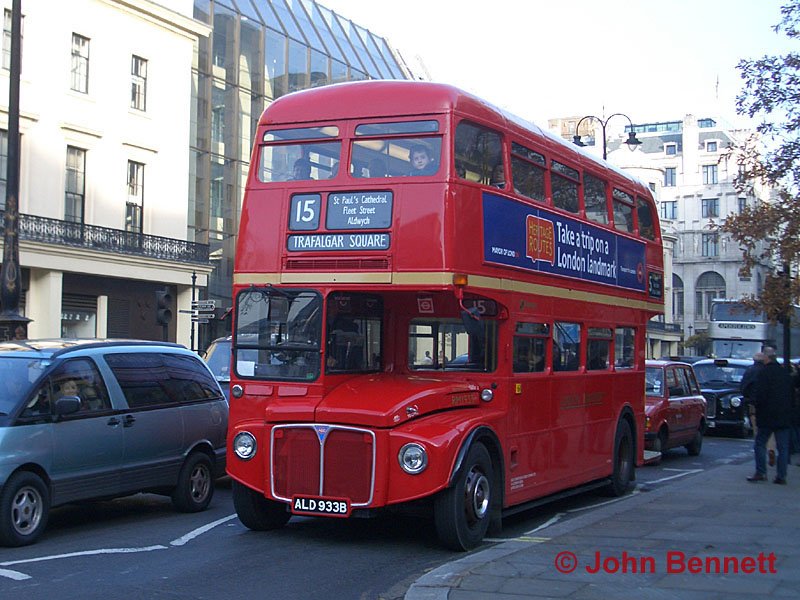 | Photo © William Turvill. |
Home | Bus routes | Operational details | Service changes | Operators & Garages | Photo gallery
The 15 is a particularly “touristy” route passing as it does several major attractions as it runs from one end of central London to the other. Not least the Tower of London and Tower Bridge, the 15 until recently being the only route to serve these places apart from more city-orientated routes, but not forgetting St. Paul’s, Trafalgar Square and so on. The route no longer reaches Oxford Street, however.
Whilst former Mayor Ken Livingstone pursued a policy of replacing Routemasters with modern low floor buses, he also made numerous references to intentions to keep a few on a "heritage tourist route." The 15 seemed to be the ideal candidate, so not a few eyebrows were raised when the route's conversion to one-person operation was announced. This also came as a particular disappointment to enthusiasts, as the 15 had been host to quite a number of "unusual" Routemasters, and all were immaculately presented.
OPO conversion allowed the route’s transfer to Bow garage, freeing up additional space at Upton Park for other routes previously run from Bow. New Tridents were ordered, but these have now passed on and been replaced by hybrid double deckers – there is something of a push to get these on central London routes. Two photographs have been provided of those, and firstly we have 12128 (LX61 DFD) outside the grand frontage of Charing Cross mainline railway station on 1 February 2012. The station takes its name from the old name for the area and the Eleanor Cross that was located here and which was widely regarded as the centre point of London; for the railways to reach this point was quite an achievement, so to emphasise this, the original having long gone, the railway company built a replacement cross as the centrepiece of its forecourt, which is visible on the right of the picture, along with a couple of the ubiquitous "Boris bikes!"
 | Photo © William Turvill. |
"Regent Street" is now the normal terminus of the 15, the route having been cut back to that point from Paddington in August 2010 in a scheme to help reduce over-bussing in Oxford Street, with route 159 extended there (from Marble Arch) in its place. When the change was introduced buses did not have Regent Street on the blinds and had to show Oxford Circus instead, even though the last stop is well short of that point – one illustration of the advantages of modern dot matrix destination displays over traditional blinds, which could have been changed overnight.
At the other end of the route is 12136 in the mini-bus station at Blackwall DLR station, which is only served by this one route. This point is not much of a traffic objective or interchange, but terminating here means buses on route 15 can miss the severe congestion in the Canning Town area where the A13 crosses the Lee Valley. Indeed, those that do want Canning Town have the option of using the DLR from here rather than other buses. The station and railway viaduct is in the background. The blind box is set back from the curved glass on the front of the bus, resulting in some interesting reflections!
 | Photo © David McKay. |
Other bus types appear on the 15 from time to time and one is the Scania Omnicity, and the class is represented by 15033 (LX58 CGD) also at Charing Cross Station but facing the other way towards Trafalgar Square (where the original Cross was located), on a short working to Aldgate on 18 July 2009. This is cheating slightly, as this was prior to takeover of the company by Stagecoach and during a period when the route was run from West Ham garage, where this particular bus remains based, but luckily this bus was devoid of fleetnames! Whether the healthy load would be replicated now that the route does not serve Oxford Street I know not.
 | Photo © Stephen Gillett. |
The 15 has had a long association with route number 23, although the 23 disappeared for a while. As well as running east to East Ham, and on to Dagenham via the Barking By-Pass, buses also ran west as far as Acton. The former is now covered by route 115 during the day, and the latter by routes 7 and 23.
So what happened about the heritage routes? After much ado two routes were eventually announced, initially as 'A' and 'B' although it was not intended that these would be their final numbers. Both routes are effectively short workings on existing routes, to avoid any potential complications in the future: from 2017 all services will have to be operated by Disability Discrimination Act compliant vehicles, or else alternatives must exist to make the same journey by exactly the same means, and the Mayor/TfL had decided to bring this deadline forward to 2006 for their own services (with a handful of exceptions!).
One of the two routes, awarded to Stagecoach, was for services between Trafalgar Square and Tower Hill, covering the most “touristy” section of the 15 taking in the Tower, Monument, St. Paul’s Cathedral and Trafalgar Square. Although an extension to the Oxford Street area might have been expected, this road was explicitly excluded from any proposals from the outset due to the severe congestion already experienced. In the end it was decided that the number of the parallel route 15 should be adopted for the Routemasters, and certainly this looks more natural than 'B' or one of the higher vacant numbers, although there is some potential for confusion with the main 15.
Ten buses were allocated to each operator; 5 buses are needed for the daily turnout, plus 3 operational spares and two vehicles as a “strategic reserve.” Despite having only a couple of weeks to get the vehicles ready after they came off frontline service, Stagecoach put in a commendable effort and managed to turn out 5 immaculately presented RMs for the first day launch, the first journey being driven by none less than Peter Hendy, managing director of TfL surface transport.
 | Photo © John Bennett. |
Here RM1933 is nearing the end of a westbound journey in The Strand on Friday 9 December 2005 – this was the launch vehicle, operations having commenced the previous month just before the final "real" Routemasters bowed out. Tourists will no doubt be happy, but for the purists there are many non-authentic features on these buses following their major refurbishment in the early 2000s when the Mayor was increasing rather than reducing Routemaster numbers. Externally there is not too much to object to, though the ghastly strip lighting can be seen, and the photographer points out that the chrome window openings are painted red and the driver’s window has a black surround. The upper deck front quarterlight windows are also fake, rather than the original opening type.
Navigation
| Previous | Next | |
| Chronologically | E6 | 43 |
| Numerically | 13 | 16 |
Photo Gallery | Bus route list | Operational details | Service changes | Operators & Garages